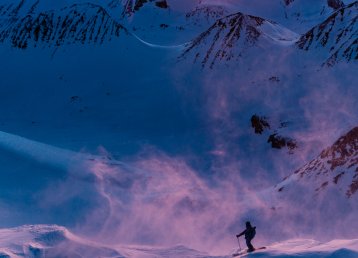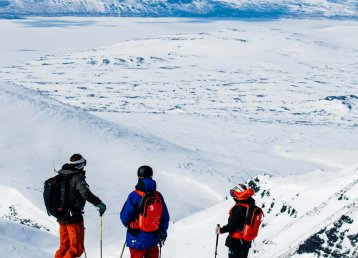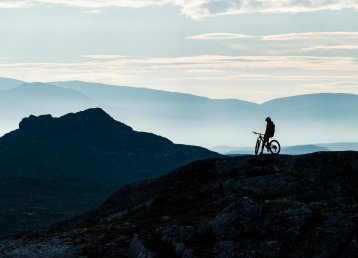The short version
The following was overheard in the restaurant at Niehku Mountain Villa in Riksgränsen, as a group having dinner walked over to get some cheese and have a chat with the chefs in the kitchen:
— Thank you kindly, that was delicious! But Ragnar, can I ask? How many seasons have you actually worked here in Riksgränsen?
— Next winter will be my tenth.
— You really must love skiing.
— No, not really. I don’t actually ski.
— I beg your pardon? How come you ended up here then?
— Well, the short version is that I was looking for a job on Gotland.
We’re going to try to account for the long version below.
A hotel like no other
Ragnar Martinsson, 33, is a chef and one of the owners of Niehku Mountain Villa. The reason he ended up in Riksgränsen is, as stated, he was looking for a job at Krakas Krog on Gotland. Sommelier Patrik Strömsten brought Ragnar north, to Meteorologen Ski Lodge.
Back then, Ragnar had no idea what he was getting himself into. He thought that if nothing else, perhaps he’d learn how to ski. That never quite happened, but on the other hand, a love for one of Sweden’s most vulnerable mountain areas – Riksgränsen – came out of it.
When the project Niehku Mountain Villa began, located above the tree line and on the border between Sweden and Norway, Ragnar didn’t hesitate. He’s now the head chef at, and partner of, this award-winning hotel.
— It has definitely been a journey, he says. Meteorologen was a great place in every sense, but when Niehku opened it was like a dream come true.
— This really is a hotel like no other.
The dream of Niehku
Niehku Mountain Villa is a stunning design hotel and a hideaway in Riksgränsen, Swedish Lapland. In an Arctic environment, this design hotel and mountain vista stand out as a pilgrimage for travelers searching for heli-skiing, good food, hikes, and a great time.
Different expressions
Over the years, there are so many who have tried to express what Riksgränsen really is, and what it means to them, but it’s proven difficult. It’s not just about the skiing, but the very passion among the skiers that creates the village atmosphere. He says it’s difficult not to be affected by that passion.
— As you can imagine, there’s going to be something special about a place that’s so clearly defined by passion. It’s always going to be a great place to hang out, with fantastic people.
— You could say Riksgränsen gets under some people’s skin. I usually say that some only come here for the one season, but then there are those who come back for a second season and they’re not going to leave.
"There’s something special about a place that’s so clearly defined by passion"
— Ragnar Martinsson
Even if Ragnar’s passion is food rather than skiing, he certainly understands those who love skiing more than anything.
— I love working with tasty food and beverages. The passion is the same, it’s just expressed differently.
A detour
Originally Ragnar is from the Swedish island Öland. He applied for a job at Krakas Krog on another island – Gotland – but when he was offered the job in Riksgränsen he figured a detour might be the best way of getting that job on Gotland. It turns out he was right. He worked at Meteorologen for three winters and at Krakas for two summers before Niehku Mountain Villa opened its doors.
— It was a special feeling, he remembers. Almost everyone who worked at Meteorologen came to Niehku. Simplifying slightly, we moved the concept to a better building and kitchen.
— We had a saying at Meteorologen: “We can’t do it, but we do it anyway.” It was a crowded space where you couldn’t take up too much room and everyone had to share. I figure we all learnt a lot there. Then we came to Niehku and there was all the space in the world all of a sudden, a kitchen that’s amazing to work in. Having worked under those other conditions beforehand just made it even better.
— Every now and then I have to just take a moment and think about what a fantastic place Niehku is.
Different dishes
He was nine, perhaps ten years old when he first said he was going to be a chef. Ragnar’s parents had moved to Öland to grow quality vegetables to sell. But that was back in the 1980s, and the market wasn’t ready for delicious tomatoes and tasty cucumbers. The market was still focused on the price tag. The result of this was that his family now boasts a first-rate hobby vegetable garden.
"I like the concept 'whole beast cooking' — using everything on an animal"
— Ragnar Martinsson
Ragnar’s view on produce has inevitably been shaped by his childhood and in his world it’s often the produce that decides what’s served. Every year Niehku buys a mountain cow and calf from Mathantverket in Vuollerim, for example.
— That usually lasts us the entire year, he says. But we adapt our dishes to what we can cook. Some meat is good for slow cooking, other meat works best on the grill.
— I like the concept ‘whole beast cooking’. Using everything on an animal. Instead of just ordering x kilos of entrecôte because we have a grill, we offer different dishes depending on what meat we have left. The cuts of meat decide the menu, not the other way around.
Firm favourites
Ragnar’s sense for produce and flavours were developed in the south of Sweden, but the first summer he spent in Riksgränsen he was surprised to see that much of what’s found on Öland is also available here.
— The difference is probably the time of year. The first vegetables arrive in spring, but here in Riksgränsen spring might be after midsummer. Willow herb is one of my favourites, especially when it’s young shoots. But sometimes it doesn’t go into flower all summer.
He says ptarmigan and angelica were two things he hadn’t encountered before, and that both have become firm favourites.
— We don’t serve ptarmigan that often here at Niehku, but many probably remember our ‘ptarmigan dumplings’ in broth. Angelica, on the other hand, is a plant and an ingredient that we feature quite a lot. Amazingly there’s an abundance of it right here, between our staff accommodation and the restaurant itself. It takes no more than a day or two to gather much of the angelica we need for the rest of the year.
The snowboarder
Before breaking his back, all Niklas Ekstedt — the host at Swedish TV and acclaimed Michelin star chef with restaurants in London and Stockholm — wanted was to be a pro snowboarder.
All these possibilities
Many associate Riksgränsen with winter and skiing more than anything else, but to Ragnar summers in the north are truly special.
— Yes. First of all, I love hiking, and in summer I can accompany our guests and share their experiences. Second of all, we don’t work as hard in summer. We are open four days a week instead of seven, which means it’s possible to think about new dishes in a different way.
In summer the menu changes its appearance a lot more frequently than in winter. When the willow herb is perfect – like crunchy asparagus – it’s a given on the menu, but when it’s grown and become a bit too fibrous there are other plants on the menu.
— This means summer is more dynamic in terms of what we create in the restaurant, and I think that’s why many guests come here, too: you go hiking on the first day, then on your mountain bike the second, and on the third day you visit the Norwegian fiords.
— That’s why summer is my favourite season. It brings all these possibilities, both in the kitchen and in nature.






























